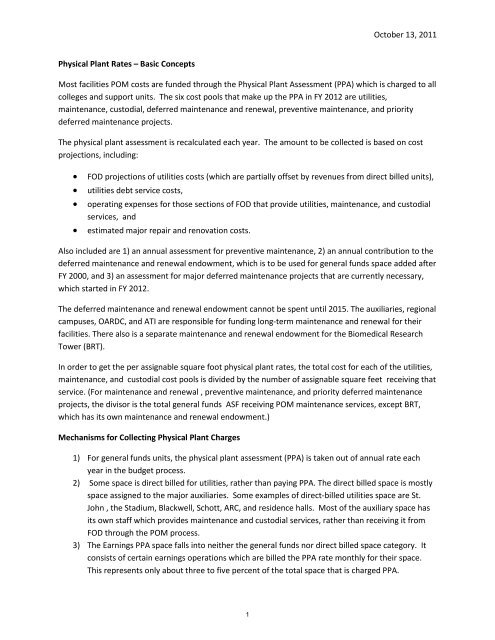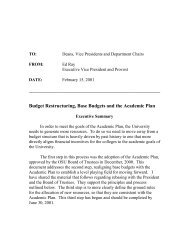Current POM documents (FY 2012) - Financial Planning & Analysis
Current POM documents (FY 2012) - Financial Planning & Analysis
Current POM documents (FY 2012) - Financial Planning & Analysis
- No tags were found...
You also want an ePaper? Increase the reach of your titles
YUMPU automatically turns print PDFs into web optimized ePapers that Google loves.
October 13, 2011Physical Plant Rates – Basic ConceptsMost facilities <strong>POM</strong> costs are funded through the Physical Plant Assessment (PPA) which is charged to allcolleges and support units. The six cost pools that make up the PPA in <strong>FY</strong> <strong>2012</strong> are utilities,maintenance, custodial, deferred maintenance and renewal, preventive maintenance, and prioritydeferred maintenance projects.The physical plant assessment is recalculated each year. The amount to be collected is based on costprojections, including:• FOD projections of utilities costs (which are partially offset by revenues from direct billed units),• utilities debt service costs,• operating expenses for those sections of FOD that provide utilities, maintenance, and custodialservices, and• estimated major repair and renovation costs.Also included are 1) an annual assessment for preventive maintenance, 2) an annual contribution to thedeferred maintenance and renewal endowment, which is to be used for general funds space added after<strong>FY</strong> 2000, and 3) an assessment for major deferred maintenance projects that are currently necessary,which started in <strong>FY</strong> <strong>2012</strong>.The deferred maintenance and renewal endowment cannot be spent until 2015. The auxiliaries, regionalcampuses, OARDC, and ATI are responsible for funding long-term maintenance and renewal for theirfacilities. There also is a separate maintenance and renewal endowment for the Biomedical ResearchTower (BRT).In order to get the per assignable square foot physical plant rates, the total cost for each of the utilities,maintenance, and custodial cost pools is divided by the number of assignable square feet receiving thatservice. (For maintenance and renewal , preventive maintenance, and priority deferred maintenanceprojects, the divisor is the total general funds ASF receiving <strong>POM</strong> maintenance services, except BRT,which has its own maintenance and renewal endowment.)Mechanisms for Collecting Physical Plant Charges1) For general funds units, the physical plant assessment (PPA) is taken out of annual rate eachyear in the budget process.2) Some space is direct billed for utilities, rather than paying PPA. The direct billed space is mostlyspace assigned to the major auxiliaries. Some examples of direct-billed utilities space are St.John , the Stadium, Blackwell, Schott, ARC, and residence halls. Most of the auxiliary space hasits own staff which provides maintenance and custodial services, rather than receiving it fromFOD through the <strong>POM</strong> process.3) The Earnings PPA space falls into neither the general funds nor direct billed space category. Itconsists of certain earnings operations which are billed the PPA rate monthly for their space.This represents only about three to five percent of the total space that is charged PPA.1
October 13, 2011Basic QuestionsDo colleges and support units get billed/reimbursed when they add/subtract space?A college or support unit is billed/reimbursed for the entire amount when it adds/subtracts space (notjust the marginal increase).Is unoccupied space included in <strong>POM</strong> rates?The rates were calculated based on ASF numbers and <strong>POM</strong> costs for all space receiving <strong>POM</strong> services.This includes 650,000 to 700,000 ASF that is classified as General University. This is mostly classroompool, inactive, and alteration space. <strong>POM</strong> for this space is paid centrally, by Resource <strong>Planning</strong>. It is notcharged to the colleges and support units.Why does some space receive only one or two of the three <strong>POM</strong> services?Most space receives all three services, but there are some exceptions, mostly in buildings that housesomething other than the usual mix of classrooms and office space. For examples, storage buildingsmay have limited or no space that receives utilities or custodial service. Food service areas that areoperated as departmental earnings operations (e.g., Wexner Café) or animal housing facilities in ULARmay have unique custodial needs that may be best met by someone other than FOD.What are the <strong>POM</strong> surcharges?Because the projected utilities costs per assignable square foot for the Biomedical Research Tower aremore than 10% in excess of the rate for the rest of the university, BRT occupants pay utilities surchargesin addition to the physical plant assessment. BRT utilities costs for <strong>FY</strong> <strong>2012</strong> were forecast to be 27% (or$2.15 per ASF) in excess of PPA. Surcharges for higher-than-average physical plant costs are also usedfor utilities in the McCorkle Aquatic Facility and RPAC. Two new ones were proposed in <strong>FY</strong> <strong>2012</strong> but notapproved by CDS: Scott Lab and the Physics Research Building.What is the New Facilities component of the Physical Plant rate?For space changes that reflect actual increases/decreases in <strong>POM</strong> space that occurred during the 12-month period prior to the December 31 cutoff for space data used in calculation of the physical plantrate (and thus are included in the ASF numbers used for the calculation and on the Schedule As), FODoperating costs and major Repair and Renovation costs are built into the New Facilities component ofthe rate. (This actually shows up on the spreadsheet split among the utilities, maintenance, andcustodial cost pools.) After the budget process, these amounts are transferred into the FOD operatingbudgets and the central Repair and Renovation program. The cost of new space is already built into thebudget projections for central utilities costs (e.g., Gas, Fuel Oil, Purchased Power).2
October 13, 2011How are space changes handled in <strong>POM</strong> calculations and billing?The FOD space database is updated twice per year: to reflect space as of December 31, and as of June30. The December 31 data is used in the development of the physical plant rate for the following fiscalyear as well as on the Schedule As for colleges and support units; both June 30 and December 31 data isused to identify space changes and make the subsequent cash adjustments. To reiterate, ASF numbersused in the calculation of the <strong>FY</strong> <strong>2012</strong> physical plant rates and on the <strong>FY</strong> <strong>2012</strong> Schedule As are based onspace assignments as they appeared in the middle of <strong>FY</strong> 2011 (i.e., as of December 31, 2010).For space changes that occur between January 1 and June 30, the college/support unit isbilled/reimbursed cash [in the fall] for the following fiscal year and the PBA follows in the budgetprocess for the fiscal year after that.For space changes that occur between July 1 and December 31, the college/support unit isbilled/reimbursed cash [in the spring] for the last six months of the fiscal year, and the full year’s PBAfollows in the next fiscal year’s budget process.For space changes that reflect actual increases/decreases in <strong>POM</strong> space (not moves from onecollege/support unit to another), the cash (and eventually the PBA) is transferred to/from FOD after thecolleges/support units have been billed/reimbursed. This cash is for increased/decreased FOD operatingexpenses due to space changes.Why was there such a huge increase in the utilities <strong>POM</strong> rate in <strong>FY</strong> 2007?In <strong>FY</strong> 2006 utility costs exceeded budget by almost $9 million, primarily due to increased fuel oil andnatural gas prices. A $10 million cash utility reserve allowed the university to pay its bill withoutreallocating in the middle of <strong>FY</strong> 2006, but the shortfall had to be covered by PBA in the following year.Which sections of FOD are funded through the tax, rather than PPA?Facilities Admin, Energy and Sustainability (part), Roads and Grounds Admin, Facilities Design andConstruction, Environmental Health and Safety3
Timeline of Physical Plant Rate Calculations Under Budget Restructuring<strong>FY</strong> 2003 <strong>FY</strong> 2004 <strong>FY</strong> 2005 <strong>FY</strong> 2006 <strong>FY</strong> 2007 <strong>FY</strong> 2008 <strong>FY</strong> 2009 <strong>FY</strong> 2010 <strong>FY</strong> 2011 <strong>FY</strong> <strong>2012</strong>Total Rate $8.19/ASF $8.82/ASF $9.63/ASF $10.51/ASF $12.36/ASF $13.56/ASF $14.36/ASF $14.98/ASF $15.48/ASF $15.48/ASFUtilities $3.60/ASF $4.19/ASF $4.81/ASF $5.54/ASF $7.22/ASF $7.97/ASF $8.38/ASF $8.69/ASF $8.74/ASF $8.07/ASFUtilitiesSurchargesMcCorkle:$0.03/ASFMcCorkle:$0.03/ASFMcCorkle:$0.03/ASFMcCorkle:$0.03/ASFMcCorkle:$0.03/ASFMcCorkle:$0.03/ASFRPAC:$0.04/ASFRPAC:$0.04/ASFRPAC:$0.04/ASFRPAC:$0.04/ASFBRT:$0.02/ASFBRT:$0.06/ASFBRT:$0.09/ASFBRT:$0.09/ASFMaintenance $2.50/ASF $2.52/ASF $2.61/ASF $2.73/ASF $2.76/ASF $2.97/ASF $3.16/ASF $3.32/ASF $3.48/ASF $3.50/ASFCustodial $2.09/ASF $2.11/ASF $2.15/ASF $2.12/ASF $2.19/ASF $2.37/ASF $2.47/ASF $2.52/ASF $2.56/ASF $2.57/ASFMaintenance& RenewalPreventiveMaintenancePriorityDeferredMaintenanceProjects<strong>POM</strong> SubsidySupportOfficeInflationaryIncrease100% ofInflationaryincrease$0.06/ASF $0.12/ASF $0.19/ASF $0.25/ASF $0.35/ASF $0.45/ASF $0.55/ASF $0.65/ASF100% ofInflationaryincrease100% ofInflationaryincrease75% ofInflationaryincrease50% ofInflationaryincrease50% ofInflationaryincrease50% ofInflationaryincrease$0.15/ASFFunded bycolleges$0.30/ASF$0.39/ASFFunded bycolleges4
Cost Pool DefinitionsUtilities Cost Pool: Costs of gas, fuel oil, metering/equipment installation, purchasedpower, water and sewerage, utilities chemicals, utilities repairs and renovation, utilitiesdebt service, operating expenses for utilities section of FOD. A Utility Reserve Fund isalso included in this cost pool to deal with unpredictable spikes in utility rates. The costsincluded in the Utilities cost pool are partially offset by the amount directly charged tocertain units for heat, power, and water, as well as by surcharges that are paid by theoccupants of the McCorkle Aquatic Center, Recreation and Physical Activity Center(RPAC) and Biomedical Research Tower due to the significantly higher utilities costs forthese buildings.Maintenance Cost Pool: Operating expenses for the maintenance section of FOD, aswell as the Repair and Renovation line, which is used for building maintenance projectsthat are too small for capital funding. Repair and Renovation funds are controlled andreleased by FOD.Custodial Cost Pool: Operating expenses for the custodial section of FOD and custodialcontract services.Deferred Maintenance/Renewal Cost Pool: These funds go into a restrictedendowment that is to be used only for scheduled maintenance and renewal of generalfunds space that was added after 2000. The first projects funded by this endowment willnot occur until 2015. This is charged to general funds assignable square feet that receive<strong>POM</strong> Maintenance services, except BRT. This assessment is to increase by $0.10 perassignable square foot annually until it reaches $1.00.Preventive Maintenance Cost Pool: This funding is for maintenance that is performedwhen it is needed or scheduled, and therefore is not delayed or deferred to a futureperiod. It is funded through charges to the same ASF that are charged for DeferredMaintenance/ Renewal. This rate is to increase by $0.15 annually for five years.Priority Deferred Maintenance Projects Cost Pool: Funding for the university to catchup on certain major deferred maintenance projects that are currently necessary. It isfunded through charges to the same ASF that are charged for Deferred Maintenance/Renewal. This rate may be charged annually if desired.5
TOPIC:Senate Fiscal CommitteeApril 26, 2011Plant Operation and Maintenance ChargesCONTEXT:Consistent with the principles of budget restructuring, the cost of utilities,maintenance, and a basic level of custodial services are allocated on auniform campus-wide average across general funds and earnings unitspace. Units can choose to voluntarily contract for higher levels ofservice.As part of the plan to increase the deferred maintenance and renewalcomponent for <strong>FY</strong> 12, the maintenance and renewal rate has increasedfrom $0.55 per assignable square foot to $0.65 per ASF.The preventive maintenance component was added to <strong>POM</strong> last year.This year the rate increases from $0.15 to $0.30 per ASF. This is to beused for maintenance to be performed when it is needed or scheduled,and therefore not delayed or deferred to a future period.This year an additional maintenance component is being added. Thiscomponent, to be called Priority Deferred Maintenance Projects, willprovide the funding for the university to catch up on certain majordeferred maintenance projects that are currently necessary. It isrecommended that this be funded with $0.39 per ASF.Colleges and support units have been responsible for increases inphysical plant costs and credited with costs of vacated space since <strong>FY</strong> 03.In <strong>FY</strong> 12, colleges will be: Charged an inflationary increase on space assigned to them prior toJanuary 1, 2010 and charged the full physical plant rate for spacenewly assigned to them between January 1 and December 31,2010. Credited with the costs associated with the physical plant for spacevacated by the unit between January 1 and December 31, 2010.Cost allocations are adjusted at the close of the <strong>FY</strong> to reflect changes inthe units’ space assignments through mid-<strong>FY</strong>.Costs for <strong>FY</strong> 12 will be impacted by two facilities that ceased receivingPPA services between January 1, 2010 and December 31, 2010: Vivian6
Attachment APBA returned to New Facilities Fund in <strong>FY</strong> <strong>2012</strong> Physical Plant AssessmentFacility Costs moved out of Physical Plant Assessment for closed spaceBuilding FOD Service End Date <strong>FY</strong> <strong>2012</strong> PPA ASFVivian Hall 1/1/2011 ($245,682) (36,669)Calf Barn 7/1/2010 ($71,357) (20,505) 1Decrease in Physical Plant Assessment space<strong>FY</strong> <strong>2012</strong> PPA ASF($317,040) (57,174)Units assigned space in these buildings were reimbursed in cash in <strong>FY</strong> 2011 based onthe date FOD services ended. They will be reimbursed annual rate for this space in <strong>FY</strong> <strong>2012</strong>.1 Calf Barn received only maintenance services.8
Attachment DThe Ohio State UniversityPhysical Plant RatesTrends from <strong>FY</strong> 2003 to <strong>FY</strong> <strong>2012</strong> - Recommended by Central Distributions SubcommitteeAttachment DActualRec<strong>FY</strong> 2003 <strong>FY</strong> 2004 <strong>FY</strong> 2005 <strong>FY</strong> 2006 <strong>FY</strong> 2007 <strong>FY</strong> 2008 <strong>FY</strong> 2009 <strong>FY</strong> 2010 <strong>FY</strong> 2011 <strong>FY</strong> <strong>2012</strong>Utilities $ 3.60 $ 4.19 $ 4.81 $ 5.54 $ 7.22 $ 7.97 $ 8.38 $ 8.69 $ 8.74 $ 8.07Maintenance $ 2.50 $ 2.52 $ 2.61 $ 2.73 $ 2.76 $ 2.97 $ 3.16 $ 3.32 $ 3.48 $ 3.50Custodial $ 2.09 $ 2.11 $ 2.15 $ 2.12 $ 2.19 $ 2.37 $ 2.47 $ 2.52 $ 2.56 $ 2.57Maintenance & Renewal $ - $ - $ 0.06 $ 0.12 $ 0.19 $ 0.25 $ 0.35 $ 0.45 $ 0.55 $ 0.65Preventive Maintenance $ - $ - $ - $ - $ - $ - $ - $ - $ 0.15 $ 0.30Priority Deferred Maint Projects $ - $ - $ - $ - $ - $ - $ - $ - $ - $ 0.39Total Rate $ 8.19 $ 8.82 $ 9.63 $ 10.51 $ 12.36 $ 13.56 $ 14.36 $ 14.98 $ 15.48 $ 15.48Percentage Change<strong>FY</strong> 2003 <strong>FY</strong> 2004 <strong>FY</strong> 2005 <strong>FY</strong> 2006 <strong>FY</strong> 2007 <strong>FY</strong> 2008 <strong>FY</strong> 2009 <strong>FY</strong> 2010 <strong>FY</strong> 2011 <strong>FY</strong> <strong>2012</strong>Utilities 16.4% 14.8% 15.2% 30.3% 10.4% 5.1% 3.7% 0.6% -7.7%Maintenance 0.8% 3.6% 4.6% 1.1% 7.6% 6.4% 5.1% 4.8% 0.6%Custodial 1.0% 1.9% -1.4% 3.3% 8.2% 4.2% 2.0% 1.6% 0.4%Maintenance & Renewal na na 100.0% 58.3% 31.6% 40.0% 28.6% 22.2% 18.2%Preventive Maintenance na na na na na na na na 100.0%Priority Deferred Maint Projects na na na na na na na na naTotal Rate 7.7% 9.2% 9.1% 17.6% 9.7% 5.9% 4.3% 3.3% 0.0%11
Physical Plant Assessment BackgroundPrior to budget restructuring, only major Auxiliary and Earnings operations paidfor their physical plant costs, directly or through a Physical Plant Assessment (PPA). Themethodology used to calculate the PPA differed from the one adopted with budgetrestructuring. Pre-budget restructuring, the PPA was not calculated as one uniform rateper assignable square foot (ASF) for each of the physical plant cost pools, as it is today.Rather, for each type of service (custodial, maintenance, and utilities) it was calculated bydividing the adjusted net square feet of the Earnings operation by its net to gross squarefeet ratio times a “level of service factor” times the average per gross square foot cost ofa basic level of service. The basic level of services was assigned a level of service factorof “1;” higher and lower levels of service had corresponding factors. The cost of thebasic level of service was calculated by multiplying historical costs by an inflation factor.The level of service factors were not updated after about <strong>FY</strong> 1990.The implementation of the new methodology for the PPA began in <strong>FY</strong> 2002.This methodology includes a university-wide average cost per component timesassignable square feet, as opposed to the old methodology of using average cost per grosssquare foot times a service level factor. The new PPA is assessed to General Funds unitsas well as to Earnings operations.Although physical plant costs were calculated in <strong>FY</strong> 2002 using the newmethodology, the allocation of revenues and space costs did not occur until <strong>FY</strong> 2003..13




